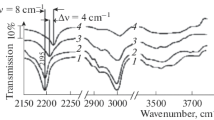Abstract—
This paper demonstrates the feasibility of using induction constants for quantitatively assessing the reactivity of hydroxyl groups on the surface of some solid oxides in the synthesis of nanostructures by molecular layering (atomic layer deposition). It is shown that a surface reaction can reach completion if hydroxyl groups have a larger induction constant than does the active group of the reagent. The proposed approach is substantiated and experimental data are presented for solid silicon, aluminum, magnesium, titanium, and beryllium oxides.



Similar content being viewed by others
REFERENCES
Malygin, A.A. and Smirnov, V.M., Early work on atomic layer deposition cited, Solid State Technol., 2002, vol. 45, pp. 14–17.
Puurunen, R., Surface chemistry of atomic layer deposition: a case study for the trimethylaluminum/water process, J. Appl. Phys., 2005, vol. 97, paper 121301.
Pal’m, V.A., Osnovy kolichestvennoi teorii organicheskikh reaktsii (Principles of Quantitative Theory of Organic Reactions), Leningrad: Khimiya, 1977.
Aleskovskii, V.B., On the nature of solid chemical compounds, Zh. Prikl. Khim. (Leningrad), 1982, vol. 55, no. 4, pp. 725–730.
Aleskovskii, V.B., Khimiya nadmolekulyarnykh soedinenii (The Chemistry of Supramolecular Compounds), St. Petersburg: SPbGU, 1996.
Ezhovskii, Yu.K., Surface reactivity of single-crystal silicon in atomic layer deposition processes, Inorg. Mater., 2019, vol. 55, no. 2, pp. 101–105.
Spravochnik khimika (Chemist’s Handbook), Leningrad: Khimiya, 1971, vol. 3.
Ezhovskii, Yu.K. and Osipov, A.V., A thermodynamic model for the formation of surface functional groups, Poverkhnost, 1999, no. 3, pp. 39–43.
Tsyganenko, A.A. and Filimonov, V.N., IR spectra of the hydroxyl shell of oxides with the wurtzite structure, Dokl. Akad. Nauk SSSR, 1972, vol. 203, pp. 636–639.
Tsyganenko, A.A., Khomenya, A.V., and Filimonov, V.N., Proton donor ability of OH groups on oxide surfaces studied by IR spectroscopy, Adsorbts. Adsorbenty, 1976, vol. 4, pp. 86–90.
Ezhovskii, Yu.K., Nanolayers of tantalum- and aluminum oxides and dielectric compositions based on them, J. Surf. Invest.: X-ray, Synchrotron Neutron Tech., 2021, no. 2, pp. 267–272.
Author information
Authors and Affiliations
Corresponding author
Additional information
Translated by O. Tsarev
Rights and permissions
About this article
Cite this article
Ezhovskii, Y.K. Reactivity of Hydroxyl Groups on the Surface of Solid Oxides in Atomic Layer Deposition Processes. Inorg Mater 57, 913–918 (2021). https://doi.org/10.1134/S0020168521090065
Received:
Revised:
Accepted:
Published:
Issue Date:
DOI: https://doi.org/10.1134/S0020168521090065



